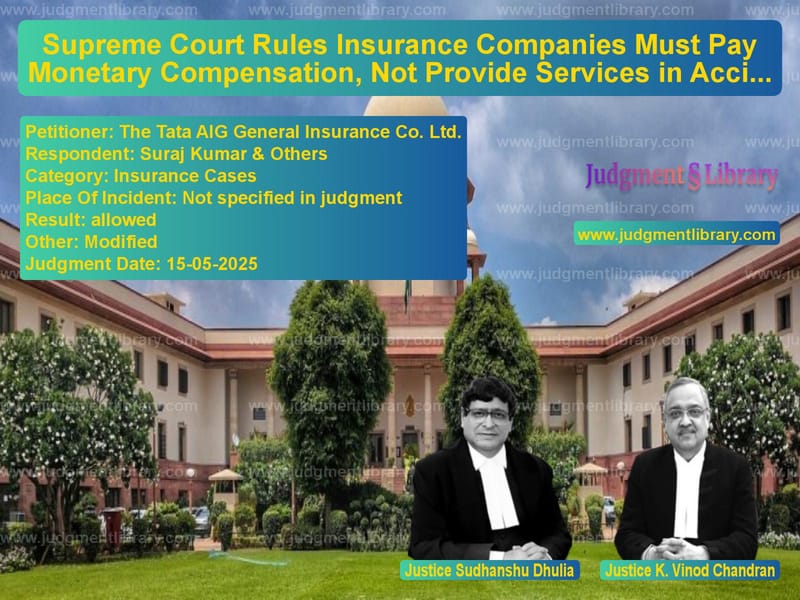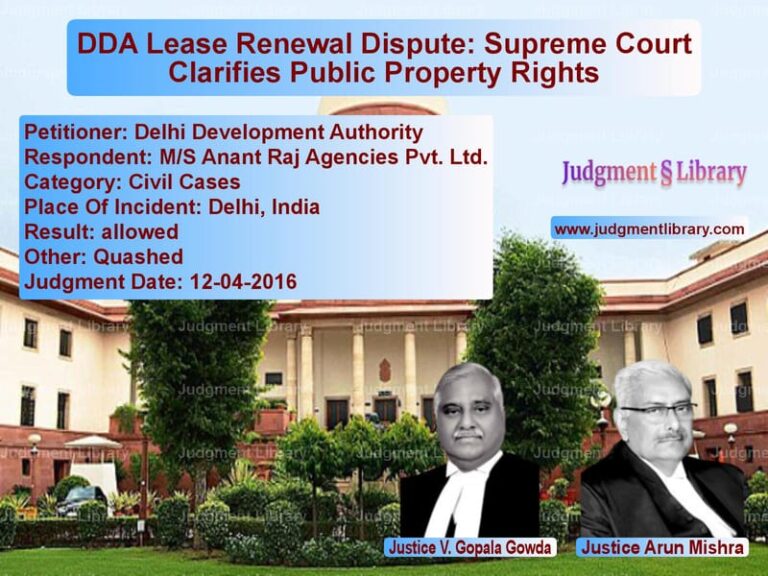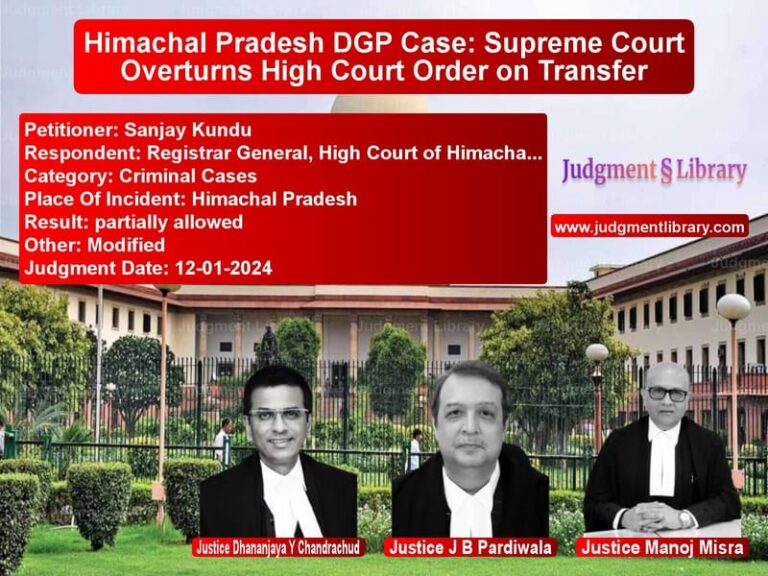Supreme Court Rules Insurance Companies Must Pay Monetary Compensation, Not Provide Services in Accident Cases
In a landmark judgment that clarifies the legal obligations of insurance companies in motor accident cases, the Supreme Court of India has ruled that insurers cannot be compelled to provide ongoing services or monitor accident victims’ wellbeing, but must instead pay comprehensive monetary compensation that covers all future needs. The case of The Tata AIG General Insurance Co. Ltd. versus Suraj Kumar & Others represents a significant clarification of the legal boundaries between insurance liability and victim compensation, balancing the practical realities of insurance contracts with the genuine needs of accident victims.
The judgment, delivered by a bench comprising Justice Sudhanshu Dhulia and Justice K. Vinod Chandran, addresses a unique situation where the High Court had directed an insurance company to provide prosthetic limbs, a motorized wheelchair, and ongoing monitoring services to a severely disabled accident victim. While acknowledging the humanitarian impulse behind the High Court’s order, the Supreme Court firmly established that an insurance company’s role is limited to providing monetary compensation rather than becoming involved in the long-term care and monitoring of accident victims.
The case revolves around a tragic accident that occurred on December 21, 2008, when Suraj Kumar, then just 22 years old, was working as a cleaner in a tempo belonging to his employer. The vehicle was being driven rashly and negligently when it collided with a stationary tanker, resulting in catastrophic injuries for the young man. The accident left him with both lower limbs severely impaired, with one leg amputated and 90% impairment in both limbs—essentially rendering him completely immobile and dependent on assistance for basic mobility.
The Legal Journey Through Lower Courts
The case traveled through the established legal channels for motor accident claims, beginning with the Motor Accident Claims Tribunal. The Tribunal examined substantial evidence regarding the accident, including proof of negligence in driving, and medical evidence establishing the extent of the victim’s disabilities. The medical evidence included testimony from the treating doctor, a medical technician, and a doctor who was part of the medical board that assessed the victim’s disability and issued the official certificate.
The Tribunal assessed the victim’s income at Rs. 4,000 per month, added 50% for future prospects, and applied a multiplier of 17 to calculate the compensation. Recognizing the severity of the injuries—with functional disability assessed at 100%—the Tribunal awarded total compensation of Rs. 16,34,400 along with 9% interest. This amount covered both pecuniary and non-pecuniary aspects of the victim’s losses.
Significantly, the insurance company did not challenge this award by filing an appeal, suggesting they found the Tribunal’s decision reasonable and within the bounds of their liability. However, the victim himself felt that the compensation was insufficient to address his long-term needs and filed an appeal before the High Court.
The High Court’s Unconventional Order
The High Court, in what the Supreme Court would later describe as an “ideal” approach from a humanitarian perspective, took an unconventional route in addressing the victim’s needs. Rather than simply increasing the monetary compensation, the High Court directed the insurance company to provide specific goods and services to the victim.
The High Court’s order required Tata AIG General Insurance Company to provide prosthetic limbs and one motorized wheelchair “to the satisfaction of the victim.” Beyond merely providing these items, the court imposed ongoing obligations on the insurance company, including providing the telephone numbers of two responsible officers, paying for the victim’s travel from Patna to Delhi for fitting the prosthetic limbs and procuring the wheelchair, and—most unusually—ensuring the proper functioning of the prosthetic limbs and wheelchair at least twice a year, presumably to facilitate replacements as needed.
This approach represented a significant departure from the traditional method of calculating and awarding monetary compensation in accident cases, instead attempting to create a long-term relationship between the insurance company and the victim to ensure his ongoing wellbeing.
The Insurance Company’s Challenge
Tata AIG General Insurance Company approached the Supreme Court challenging the High Court’s order, raising fundamental questions about the nature and scope of insurance liability in motor accident cases. The insurance company’s central argument was straightforward and legally grounded: “as an insurer, the liability is only to indemnify the loss of estate of the insured, that too, in monetary terms, by pecuniary compensation as awarded by the Tribunal.”
The company further contended that “Monitoring the victim of the accident and ensuring his wellbeing in future will not be the duty of the insurer nor can such an obligation be cast on it.” This argument highlighted the practical and legal difficulties of requiring a commercial insurance company to take on what amounted to long-term healthcare and support responsibilities for accident victims.
The insurance company’s position reflected the traditional understanding of insurance contracts as financial risk management tools rather than service providers. Their role, as they saw it, was to provide financial compensation that would enable victims to access the goods and services they needed, not to become directly involved in providing those goods and services.
The Supreme Court’s Analysis and Reasoning
The Supreme Court, in its judgment authored by Justice K. Vinod Chandran, carefully analyzed the legal principles involved while maintaining sensitivity to the victim’s tragic circumstances. The Court began by acknowledging the humanitarian impulse behind the High Court’s order, noting that “We cannot accept the order of the High Court though it would, to some extent, be an ideal one by ensuring the victim’s well being.”
However, the Court firmly agreed with the insurance company’s legal position, stating: “We are of the opinion that the appellant is perfectly right in raising such a contention against the impugned order.” The judgment elaborated on the legal principles governing insurance liability, emphasizing that “The Insurance Company which has indemnified the owner of the motor vehicle as against any loss of estate caused by reason of an accident of the vehicle cannot be required to ensure the future wellbeing, which in any event can be computed in monetary terms and awarded as ‘just compensation’.”
The Court suggested a more appropriate approach would have been for the High Court to “compute the monetary compensation which would cover the aspect of provision of mobility and prosthetic limb, as also compute in monetary terms, as to what would ensure the future wellbeing of the victim.” This could have been achieved by “ascertaining the price of the wheelchair or the prosthetics and also the periodicity of replacement while awarding attendant charges and future treatment expenses.”
Calculating Comprehensive Monetary Compensation
Rather than simply setting aside the High Court’s order and ending there, the Supreme Court took the extraordinary step of calculating what would constitute adequate monetary compensation for the victim’s long-term needs. The Court recognized that “Looking at the total picture of the disability, the requirement for providing sufficient mobility to the victim, as also the future medical expenses, would be incidental to the future wellbeing of the victim.”
The Court made specific calculations based on the victim’s age and needs: “The victim was 22 years old when he was rendered almost immobile by the injuries suffered in an accident. A prosthetic limb, would in any event cost approximately Rs.2 lakhs and it would have to be changed in every five years. Even on a conservative estimate, the victim would require the change of at least five prosthetic limbs in his lifetime considering his age.”
Similarly, for the wheelchair: “The provision of wheelchair would also take approximately Rs.40,000/- which also would have to be changed every five years.” Based on these calculations, the Court determined that “the total amount of Rs.10 lakhs for the prosthetic limbs and another Rs.2 lakhs for the wheelchair would take care of the future wellbeing of the victim.”
The Final Award and Directions
In a decision that balanced legal principles with practical compassion, the Supreme Court directed the insurance company to pay an additional amount of Rs. 12 lakhs to the victim with simple interest at 6%, to be paid within two months. The Court acknowledged the unusual circumstance that “the claimant has not approached this Court, and the appeal is filed by the Insurance Company,” but justified its decision by noting that “before the High Court it was the claimant who filed the appeal for compensation” and that “we are not increasing the award but only stating the award in monetary terms as is prayed now before this Court by the Insurance Company.”
The Court also considered the lengthy passage of time since the accident, noting that “the accident occurred almost a decade and a half before” and therefore “We do not think a remand would be proper.” This practical approach prevented further delays in providing the victim with the compensation he needed.
The Supreme Court set aside the High Court’s impugned order and disposed of the appeal with specific directions for payment: “The respondent is directed to provide the details of his account into which the insurance company shall deposit/transfer the balance amounts due, after deducting the amounts already paid if any, through online mode within the time as stipulated above.”
Broader Implications of the Judgment
This Supreme Court judgment has significant implications for motor accident compensation law in India. First, it firmly establishes that insurance companies cannot be compelled to provide services or ongoing monitoring of accident victims—their liability is strictly financial. This clarification provides important legal certainty for insurance companies regarding the scope of their obligations.
Second, the judgment emphasizes that courts should compute comprehensive monetary compensation that adequately covers all of a victim’s future needs, including periodic replacement of medical devices and ongoing treatment expenses. This approach respects the contractual nature of insurance while ensuring victims receive compensation that truly addresses their long-term requirements.
Third, the Court’s detailed calculation of future needs based on the victim’s age and the lifespan of medical devices provides a practical framework for lower courts to follow in similar cases. This methodology ensures that compensation awards are grounded in realistic assessments of actual costs rather than arbitrary figures.
Finally, the judgment demonstrates the Supreme Court’s ability to balance strict legal principles with compassionate consideration of victims’ needs. While rejecting the High Court’s unconventional approach as legally untenable, the Court nonetheless ensured that the victim received adequate financial compensation to address his lifelong needs resulting from the catastrophic injuries.
Conclusion
The Supreme Court’s judgment in The Tata AIG General Insurance Co. Ltd. versus Suraj Kumar & Others represents an important clarification of the legal boundaries governing insurance company liability in motor accident cases. By establishing that insurers must provide comprehensive monetary compensation rather than ongoing services, the Court has provided clarity while ensuring that accident victims receive adequate financial support for their long-term needs.
The case illustrates how the legal system can adapt to address the complex, lifelong consequences of catastrophic injuries while respecting the contractual nature of insurance relationships. The Court’s approach—rejecting the High Court’s well-intentioned but legally problematic order while substantially increasing the monetary compensation—demonstrates a sophisticated understanding of both legal principles and human needs.
For accident victims, insurance companies, and legal practitioners, this judgment provides valuable guidance on how to approach compensation for long-term needs resulting from serious injuries. It emphasizes that the solution lies not in creating ongoing relationships between victims and insurers, but in ensuring that monetary compensation is comprehensive enough to cover all foreseeable future expenses, thereby truly serving the objective of providing ‘just compensation’ to those whose lives have been forever altered by motor accidents.
Petitioner Name: The Tata AIG General Insurance Co. Ltd..Respondent Name: Suraj Kumar & Others.Judgment By: Justice Sudhanshu Dhulia, Justice K. Vinod Chandran.Place Of Incident: Not specified in judgment.Judgment Date: 15-05-2025.Result: allowed.
Don’t miss out on the full details! Download the complete judgment in PDF format below and gain valuable insights instantly!
Download Judgment: the-tata-aig-general-vs-suraj-kumar-&-others-supreme-court-of-india-judgment-dated-15-05-2025.pdf
Directly Download Judgment: Directly download this Judgment
See all petitions in Motor Insurance Settlements
See all petitions in Insurance Settlements
See all petitions in Compensation Disputes
See all petitions in Road Accident Cases
See all petitions in Third-Party Insurance
See all petitions in Judgment by Sudhanshu Dhulia
See all petitions in Judgment by K. Vinod Chandran
See all petitions in allowed
See all petitions in Modified
See all petitions in supreme court of India judgments May 2025
See all petitions in 2025 judgments
See all posts in Insurance Cases Category
See all allowed petitions in Insurance Cases Category
See all Dismissed petitions in Insurance Cases Category
See all partially allowed petitions in Insurance Cases Category







